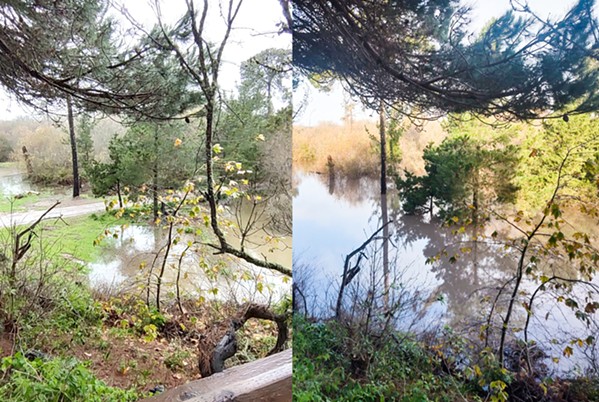[{
"name": "Ad - Medium Rectangle CC01 - 300x250",
"id": "AdMediumRectangleCC01300x250",
"class": "inlineCenter",
"insertPoint": "8",
"component": "2963441",
"requiredCountToDisplay": "12"
},{
"name": "Ad - Medium Rectangle LC01 - 300x250",
"id": "AdMediumRectangleCC01300x250",
"class": "inlineCenter",
"insertPoint": "18",
"component": "2963441",
"requiredCountToDisplay": "22"
},{
"name": "Ad - Medium Rectangle LC09 - 300x250",
"id": "AdMediumRectangleLC09300x250",
"class": "inlineCenter",
"insertPoint": "28",
"component": "3252660",
"requiredCountToDisplay": "32"
}]
Lifelong Oceano resident Courtney Cain is water-locked.
The historic rainstorm that hit San Luis Obispo County caused Arroyo Grande Creek to rise and subsequently break the levee on the south side. Cain’s house is on a hill with a road that runs down along the creek.
“The road is probably under 10 feet of water, there’s so much flooding,” Cain said. “The house is fine, but the road is the only way in and out. We probably can’t get out for a week.”
This isn’t the first time the creek levee has broken. It ruptured in May 2001, causing heavy floods. Cain was a kid at the time, but she remembers it well.
“I couldn’t get back home for two weeks. We evacuated and stayed at a vacation rental on Strand Avenue,” she said.
Currently, Cain is stocked up with two rolls of toilet paper, some baby wipes, and 7 gallons of water. Her house is connected to a well system, so the iron-loaded tap water isn’t drinkable. The morning the storm hit on Jan. 9, Cain and her aunt, Linda Austin—an Oceano Community Services District board member—went to Vons and purchased water and food.
“By the time we got back, her [Austin’s] truck barely made it in,” she said.
The flood caused Cain’s daughter to miss school at Oceano Elementary, which reopened after two days on Jan. 11. The household also lost its Wi-Fi services but still has access to electricity. Cain hasn’t notified county officials for help yet but through Austin, she’s expecting someone to bring a boat to them. She thinks there’s more SLO County can do to help.
“They need to take responsibility for the Arroyo Grande Creek and take action in cleaning out the debris and plant life that has grown in it,” Cain said.
Next door to Cain, the livery stables at Silver Spur Place were also caught in the flood. Community members across the county pleaded online to help those horses that were stuck in a deep pool of water.
Nikka Hepperly, an animal caretaker often based in Arroyo Grande, rushed to answer those calls for help.
“I waded across waist-deep water to get them, but came back empty-handed,” she said.
Hepperly returned to dry land without horses because she was the last to join the rescue effort and that process was paused. She said roughly 20 horses were brought back, but as of Jan. 10 some remained on a patch of land surrounded by water. The local Horse Emergency Evacuation Team (HEET) told New Times that they don’t offer water rescues. President Julie Monser said that the HEET team is on standby to help with food and veterinary care once the horses are brought to safety.
As she was about to leave Silver Spur, Hepperly noticed a helicopter flying above to drop supplies. But horse owners had another concern.
“I left my number with them in case they needed more help later, but we’re worried that the horses may get scared and run into the water during helicopter rescue,” she said.
Other animals also experienced the stress of evacuation. On Jan. 9, the Cal Poly Cat Program transferred 23 cats to safer locations like the new county Animal Services facility and the homes of shelter faculty and staff.
“In the 30 years we’ve had this shelter, this is only the second time we had to evacuate cats,” said Facility Manager Sally Adam.
Adam said she’s grateful to Animal Services for making room and hosting 13 cats until the evacuation order was lifted. On Jan. 10, the Cal Poly Cat Program was waiting for the reservoir above it to be drained so they could return. The rapidity of the storm and floods took Adam’s team by surprise. The shelter has always braced itself for nearby fires—a phenomenon that’s usually slower to build, giving them ample time to monitor the situation.
“We used to be prepared [for floods] in the past. But when nothing happens for 10 to 15 years, we got lax about it,” she said. “We weren’t prepared. We’ve always felt like we’d have more time.” ∆
OTHER LOCAL STORM COVERAGE
County scrambles to provide shelter while tragedies hit
Latest in News
Readers also liked…
-

Coast Unified teachers upset over new position's salary and qualifications
Oct 20, 2022 -

SLO police identify alleged driver who hit and killed couple
Dec 22, 2022 -

When the levee breaks: Oceano residents, county officials walk a tightrope of regulations to manage Arroyo Grande Creek, which some say led to the levee's failure in January
May 18, 2023










